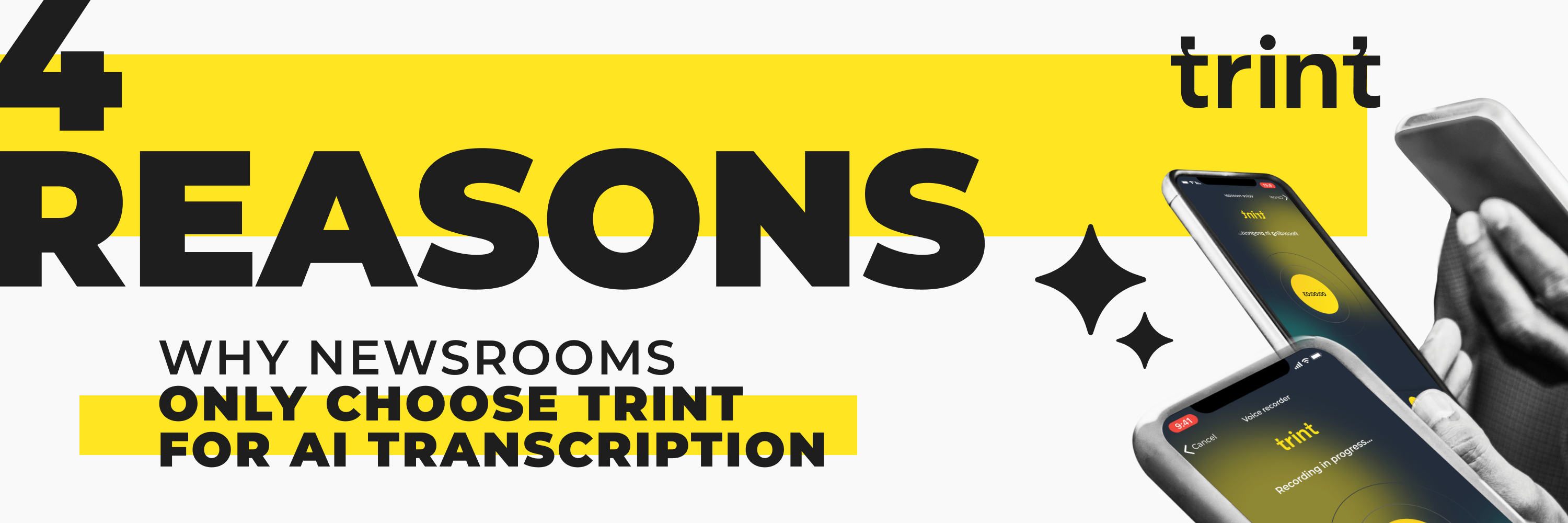
Trint has been working with the foremost media and news brands for years. Global newsrooms such as the BBC, Washington Post, Financial Times, Thomson Reuters and Associated Press rely on Trint to not only transcribe key press conferences and interviews but also transform their transcripts into breaking stories - and faster.
But when there are so many transcription options out there, complete with AI assistants that can generate summaries and key insights in a click, why do so many iconic media brands still bank on Trint as their prized platform for capturing and creating great stories?
We decided to ask them! And the feedback helped us list out four overarching reasons why they always choose Trint over the alternatives:

Trint understands news media because it was founded by an Emmy Award-winning war correspondent. Jeff Kofman enjoyed a 30-year career with ABC, CBS and CBC News but grew tired of manual transcription stopping every story in its tracks.
And that’s how Trint was born, with a mission to liberate journalists from the menial so they can focus on the meaningful. To this day, while other solutions have taken a generic approach to developing their technology, Trint has purposefully built features that meet the nuanced needs of the newsroom (more on that below).
So when it comes to putting budget towards an AI transcription solution, newsrooms know Trint will give them more bang for their buck. In sum, your money is safer with Trint.

When the Agence France-Presse (AFP) team attended COP 28 in Dubai they, along with the rest of the world’s media, would catch world leaders at the end of closed-door meetings for comment.
Other journalists were limited to either recording the dignitary’s statements then uploading the recording afterwards to transcribe; or they had access to live transcription (i.e. in real time) but if a key quote passed them by, they had no way of going back to check. Far from ideal when you’re striving to break news for readers and customers as fast as possible.
And this is where Trint is so unique for newsrooms. AFP’s team were able to not only transcribe those moments live (and in 30+ languages if they so wished) but, even more impressively, they were able to share the live transcript with remote colleagues who could rewind and verify quotes, then work on and publish breaking news alerts even faster - all while the event was unfolding and, importantly, while others newsrooms were still scrambling to make sense of what was being said.

For global newsrooms often handling sensitive information across their interview transcripts, AI can naturally feel a little risky. And it doesn’t help when (many) other transcription solutions access customer data to train their AI. Striving to improve accuracy is a noble cause but when - for example - users receive emails from those vendors enquiring about the purpose of a certain call with a certain source, or a meeting bot automatically joins and sends the transcript to all meeting invitees (including executive assistants) without acknowledging sensitivities in the conversation, then there has to be a better way.
With Trint, when we say “no one sees your data but you”, we mean it! Our AI is trained on external data sets so your call transcripts remain 100% private, while a choice of storage in the US or EU gives newsrooms far greater control over their transcripts. So you can breathe easy that sensitive transcripts will never fall into the wrong hands.

When it comes to software, is there a more painful user experience than constantly switching back and forth between different apps and programs to get work done?
While most AI transcription solutions (including Trint) offer integrations with popular collaboration and productivity apps, only Trint connects to other popular tools in the newsroom tech stack. Whether you use prominent news production systems like AP ENPS, Octopus Newsroom or Saga, Media Asset Managers (MAMs) like Mimir, or leading live video streaming solution LiveU, Trint connects effortlessly to supercharge newsroom workflows.
German media powerhouse BILD recently integrated Trint with Mimir and quickly realized huge efficiency gains by automating transcription workflows and streamlining collaboration across multiple teams. This wasn’t possible with other AI transcription technologies. In addition, our API lets you effortlessly connect Trint’s AI transcription platform to other tools – letting you seamlessly upload and export Trint files to where you work, and automating workflows so your teams can work faster and smarter.
-----------------------------------
In summary, while many other generic AI solutions might promise similar features, Trint's dedication to supporting the newsroom - from live collaborative transcription to seamless technology integrations - demonstrates why purpose-built technology outperforms one-size-fits-all alternatives.
When global media brands use Trint with their most critical content, it often goes beyond transcription speed and accuracy (which ought to be table stakes anyway). It's about working with a platform that understands the unique workflows, pressures and ethical standards that define modern journalism. And as new technology continues to reshape the profession, that understanding makes all the difference.